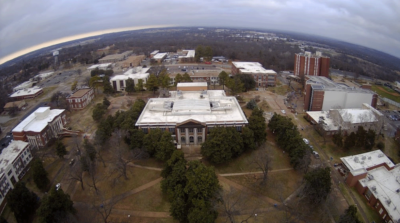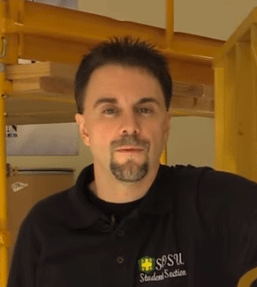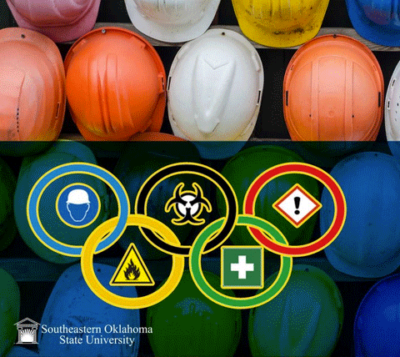
About 100 miles north of Dallas, Texas, is a small university that has a significant impact on America’s occupational safety and health. Southeastern Oklahoma State University has a highly respected Occupational Safety & Health program. It has graduated more than 1,500 students into the EHS workforce – its goal being to protect America’s workers.
Located 1,500 miles from California, it’s an attractive destination, and an excellent education either on-campus physically or virtually, for a budding safety professional.
“We’ve had many students enroll in both face-to-face and online capacities from California over the years,” says Dr. Nick Nichols, professor, and director of the J.J. Keller University Program in the Department of Occupational Safety and Health. Nichols’ safety journey started in the aftermath of a family workplace tragedy in California.

The OSH program enrolls some 400 students per year, both in-person and online. About 100 of them graduate each year. The fall semester for face-to-face classes has begun, but Nichols says that students can enroll for the Term II online courses until October 16th. Courses are offered in both formats year-round, although some are not available during the summer semester.
The program evolved from a traffic and general safety department in the 1960s and ‘70s, to its current focus on occupational safety and health in industrial settings, manufacturing, transportation, construction, and insurance. Many of its students come from the Dallas Metroplex. “We’ve had more students than I can count” from that area, Nichols says. But students also have come from such far-flung regions as Puerto Rico and the Middle East, not to mention California.
The program mixes classroom learning and hands-on training. For instance, industrial hygiene labs constitute 25% of that curriculum, both in-person and online. “Students complete experiments with various equipment that they will utilize in the field,” such as gas meters and air sample pumps, Nichols says. In the undergraduate construction safety program, which he teaches, students must build and present a scale model of a construction site, representing violative and compliance scenarios. It covers such topics as concrete, bridge and ironwork construction.
“Students are also required to assemble frame scaffolding in our Construction Safety lab,” he says, “and then complete a Job Hazard Analysis exercise regarding that assembly.” Both activities count for about 15% of the course grade. The undergraduate hazardous materials course of study requires students to complete a comprehensive HAZMAT plan for a given facility, accounting for 20% of the grade. “The project is a large one and intense in nature,” Nichols tells Cal-OSHA Reporter. “However, its goal is to provide them with a workable plan that can be utilized upon graduation.”

The school also holds an annual Safety Olympics to test top students’ knowledge and skills at SOSU and other universities. It places participants in several events over two days. They include OSHA Jeopardy to test knowledge, a mock workplace hazard inspection, a contest to test presentation skills, a safety innovation event in which teams create solutions to current safety issues, and an incident investigation of a simulated accident. Unfortunately, the pandemic forced the cancellation of this year’s event, which was scheduled for mid-April. Nichols’ wife, who also teaches in the program, has been working with other participating schools to reschedule the Olympics, COVID-permitting.
COVID Lessons
The pandemic has provided another object lesson for SOSU’s students. Nichols says it provides an opportunity to explain “how the pandemic affects the profession, federal OSHA inspections, and how socially responsible companies are responding to the pandemic (and inspections) and by relating the different career paths within the field that involve precautions we are currently taking,” such as industrial hygiene. He says he begins every face-to-face class with illustrations of healthy lungs versus COVID-infected lungs and an anecdote about double-lung transplants. “This enabled me to emphasize the importance of utilizing both the university’s mandatory COVID-19 policies, while also focusing on how it is affecting the field as a whole.”
The university protocols include strict physical distancing, face-to-face classes at 50% capacity, no sports, mandatory wearing of masks, and an online COVID reporting tool that allows students and faculty to be tested, based on temperature checks and symptoms.
A Safety Journey
Many safety professionals become interested in the profession after a friend or family member is injured or killed. That’s what happened to Nichols. In the early 1980s, one of his uncles was killed at a California oil field’s construction operation. The uncle was reaching under a pipeline section to retrieve a tool as a crane was lowering the pipe into a trench. He was crushed to death.
Nichols says he was too young to understand what happened at the time, but noticed the uncle’s absence, especially as it occurred at Christmas time. “The accident had a significant effect upon me as a child,” he says. “Although he and I were only moderately close, the experience stayed with me.” When he began considering a career after high school, he remembered the accident and asked for the whole story from his family, which had shielded him from it while he was young. “That led to my pursuing my undergraduate and graduate degrees in the field. The doctorate came much later, in the field of Vocational Education.”
What would he say to a California high school senior looking at a career in OSH? Why move 1,500 miles away to Oklahoma to study safety, or even online? “You should consider [SOSU] for your Occupational Safety and Health degree because we have both undergraduate and graduate programs offered in online formats,” he replies. “We teach the subject matter from a ‘front line’ OSH perspective, with our ultimate goal being to ‘build a better safety professional’ who is ready to go to work in the field upon graduation.
SOSU also offers safety professionals certifications in OSHA 10 and 30 hour courses in construction and general industry, as well as confined space certifications.
Attending in-person provides a small-town, rural setting, with affordable cost of living, on-campus housing “and a more personal touch with our students than that of many larger universities offering similar degrees,” Nichols adds. Need more? SOSU hasn’t raised its tuition in more than three years. And in an agreement with the Board of Certified Safety Professionals, all graduates automatically receive General Safety Practitioner status.
His final pitch to a potential student: “Our goal is, and always has been, to protect American workers, and we need you to do that!”
For more information visit www.se.edu/occupational-safety-health/ or contact SOSU’s Department of Safety and Health at 580-745-2318.

